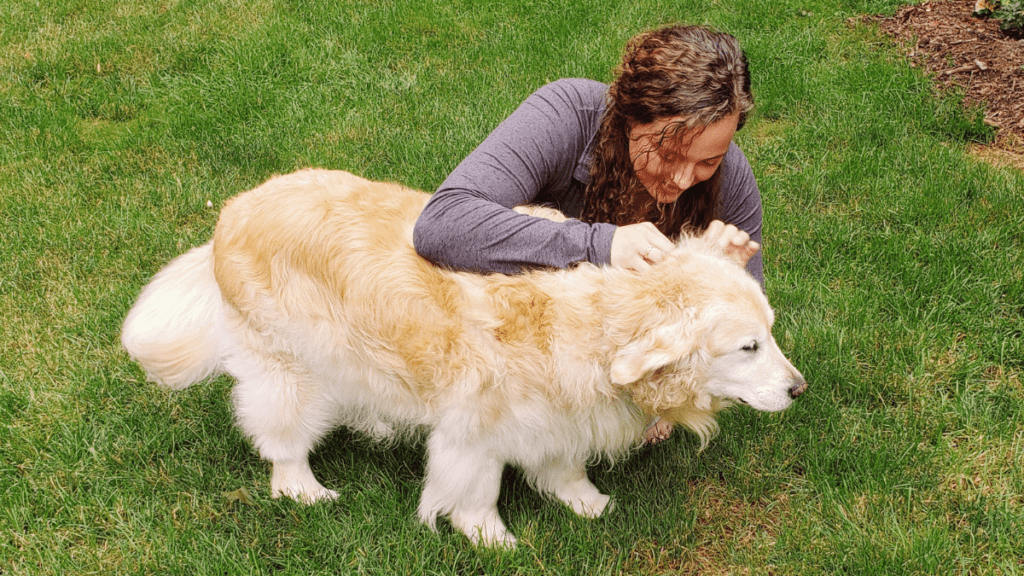Those are some of the most dreaded words we hear as dogs, second only to “It’s time for a tubby!” Although I kinda like baths… I’m weird that way. But I digress…
Hey ladies and gents! It’s me, Linda Lou, your favorite chihuahua blogger. If you missed my introduction post, you can check it out here. Today we’re discussing those tiny little buggers that burrow into our skin and suck our blood. Yuck. No dog wants to deal with a tick, and neither do our owners. So when our parents start examining us like a momma chimp examines her baby, we need to stand still and take it. Our parents are just being responsible. Even though we get Nexgard or Frontline every month, a tick can (and will) still take a chomp into our skin. The tick will die if we’re on our preventatives, but it would be nice to have them taken off before they do. So, if you want to teach your humans how to properly examine you for ticks, here’s what they need to know…
Careful attention must be paid around the tail, between the back legs, under the front legs in the armpits, between the toes, under the collar, and around the face and ears. Tell your humans that they just need to give you a nice massage, running their hands all over with gentle pressure, feeling for any little bump that is out of the ordinary. If a tick is found, it must be removed carefully so as not to leave the mouthparts in the skin. Contrary to popular belief, ticks do not have a head, but rather mouthparts. If you want to be grossed out, Google it.
To safely and completely remove a tick, grasp it firmly but gently at the skin with a pair of tweezers and pull away from the skin with steady, even pressure. Don’t twist or jerk the tick, as this can cause the mouthparts to break off. Dispose of the dirty bugger in a jar of alcohol, wrap in tape or flush down the toilet. Sometimes, despite the very best effort, the mouthparts may break off anyway. Just keep an eye on the area to make sure it does not get infected.
Ticks are more active at certain times of the year, but they can be found crawling up a blade of grass above the snow as soon as the temperature rises about 32 degrees. Yikes! I personally collected a tick on my fur in March this past year. In the wetter months like May and June you will find more of them out and about, but as the months become drier in July and August you really need to get into the woods to find them. But never let your guard down! You never know when a rogue tick will find its way onto you.
There are two species of ticks commonly seen in Minnesota. The American Dog tick (the big brown wood ticks) and the Blacklegged Tick (Deer tick). Both of them can carry diseases that can infect dogs and humans alike. The deer tick can be so hard to find, especially if it is in its “nymph” phase. Then it’s like teeny tiny. Like the size of a period on this page. A freckle with legs. This is why vaccination and prevention are so important. Those little fellas are almost impossible to find in a thick coat.
Out of the different diseases that ticks carry, the main ones we see in our area are Lyme disease, Anaplasmosis, and Ehrlichiosis. I am personally vaccinated against Lyme disease and am on Nexgard. If my mom sees that the ticks are bad at a certain time of the year, she will also add a Frontline to my protection, because we spend lots of time up North, running through the wilderness. This is safe to do, and I appreciate the extra protection.
We all want to get out and enjoy the nature around us, but let’s make it impossible for nature to enjoy us! Protect your pets against tick-borne diseases by vaccinating if appropriate and using a quality tick prevention like Nexgard or Frontline.
Later~
Linda Lou
Hey ladies and gents! It’s me, Linda Lou, your favorite chihuahua blogger. If you missed my introduction post, you can check it out here. Today we’re discussing those tiny little buggers that burrow into our skin and suck our blood. Yuck. No dog wants to deal with a tick, and neither do our owners. So when our parents start examining us like a momma chimp examines her baby, we need to stand still and take it. Our parents are just being responsible. Even though we get Nexgard or Frontline every month, a tick can (and will) still take a chomp into our skin. The tick will die if we’re on our preventatives, but it would be nice to have them taken off before they do. So, if you want to teach your humans how to properly examine you for ticks, here’s what they need to know…
Careful attention must be paid around the tail, between the back legs, under the front legs in the armpits, between the toes, under the collar, and around the face and ears. Tell your humans that they just need to give you a nice massage, running their hands all over with gentle pressure, feeling for any little bump that is out of the ordinary. If a tick is found, it must be removed carefully so as not to leave the mouthparts in the skin. Contrary to popular belief, ticks do not have a head, but rather mouthparts. If you want to be grossed out, Google it.
To safely and completely remove a tick, grasp it firmly but gently at the skin with a pair of tweezers and pull away from the skin with steady, even pressure. Don’t twist or jerk the tick, as this can cause the mouthparts to break off. Dispose of the dirty bugger in a jar of alcohol, wrap in tape or flush down the toilet. Sometimes, despite the very best effort, the mouthparts may break off anyway. Just keep an eye on the area to make sure it does not get infected.
Ticks are more active at certain times of the year, but they can be found crawling up a blade of grass above the snow as soon as the temperature rises about 32 degrees. Yikes! I personally collected a tick on my fur in March this past year. In the wetter months like May and June you will find more of them out and about, but as the months become drier in July and August you really need to get into the woods to find them. But never let your guard down! You never know when a rogue tick will find its way onto you.
There are two species of ticks commonly seen in Minnesota. The American Dog tick (the big brown wood ticks) and the Blacklegged Tick (Deer tick). Both of them can carry diseases that can infect dogs and humans alike. The deer tick can be so hard to find, especially if it is in its “nymph” phase. Then it’s like teeny tiny. Like the size of a period on this page. A freckle with legs. This is why vaccination and prevention are so important. Those little fellas are almost impossible to find in a thick coat.
Out of the different diseases that ticks carry, the main ones we see in our area are Lyme disease, Anaplasmosis, and Ehrlichiosis. I am personally vaccinated against Lyme disease and am on Nexgard. If my mom sees that the ticks are bad at a certain time of the year, she will also add a Frontline to my protection, because we spend lots of time up North, running through the wilderness. This is safe to do, and I appreciate the extra protection.
We all want to get out and enjoy the nature around us, but let’s make it impossible for nature to enjoy us! Protect your pets against tick-borne diseases by vaccinating if appropriate and using a quality tick prevention like Nexgard or Frontline.
Later~
Linda Lou






